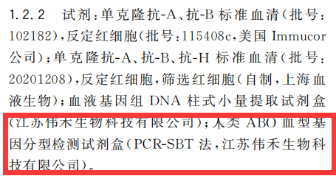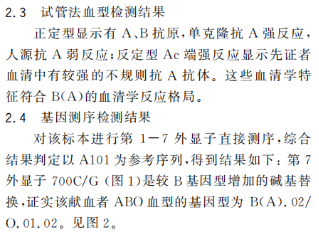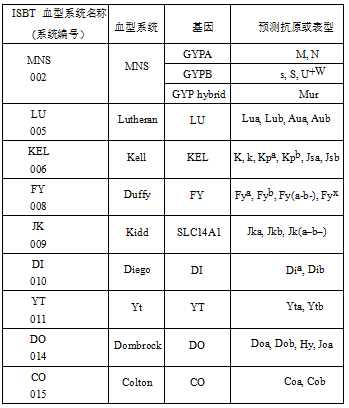

 Now Location:Home--News Center--Company News
Now Location:Home--News Center--Company News
Weihe Molecular Classroom Three---Reasons for inconsistent positive and negative typing of ABO blood types
The ABO blood type system is the earliest known blood type system in humans, and it has important clinical significance in clinical blood transfusion, forensic identification, organ transplantation, and other fields. Therefore, to ensure the safety of blood transfusion, the use of forward and reverse typing methods is required in serological techniques to ensure the accuracy of ABO blood type identification. ABO blood types can be classified into A type, B type, AB type, and O type based on the presence of A and B antigens on the surface of red blood cells and the presence of anti A and anti B antibodies in the serum. The abnormal expression of A and B antigens on red blood cells can lead to the production of ABO subtypes. Positive typing (antigen detection) and negative typing (antibody detection) respectively detect the presence of corresponding A and B antigens on red blood cells, as well as the presence of corresponding antibodies in serum. The cross referencing of positive and negative typing results can ensure the accuracy of ABO blood type identification.
At present, the main identification methods are microcolumn gel method and test tube method, of which the test tube method is the "gold standard" for blood group identification. Samples with mismatched ABO positive and negative typing in the laboratory can usually be traced, which can be due to issues with the ABO blood group antigen or antibody of the tested individual, as well as human factors or various factors related to reagent quality. Summarize the reasons for the inconsistency between ABO positive and negative typing, excluding personnel operation and reagent quality issues:
1. ABO subtype
The ABO subtype is the main cause of inconsistent ABO positive and negative typing in serological tests. The differentiation of ABO subtypes can be based on the degree of agglutination of anti A, anti A1, anti B, anti H, and anti AB, as well as through self control agglutination degree and absorption and dispersion experiments. If conditions permit, DNA sequencing and family investigation can be used for further confirmation.
Typical case: sourced from Wuhan Blood Center
References: Qu Zhen, He Mingdi, Zhao Lei, et al Identification and analysis of subtype B (A) blood type in one case [J]. Microcirculatory, 2021, 31 (3): 63-66
Sample background: The blood type (AB type) was initially screened using a fully automated blood type analyzer (B type) and paper disk method, which were inconsistent. After in vitro serological analysis, it was determined that the B (A) subtype did not match the positive and negative typing. Subsequently, exons 1-7 of the sample were detected through genetic sequencing. The primers, amplification conditions, and sequencing work used in genetic sequencing were all completed by Jiangsu Weihe Biotechnology Co., Ltd. The specific genetic testing results are as follows:


2. Insufficient or loss of ABO blood type antibodies
Due to the gradual increase in Ig-M ABO synthesis at birth, there is often inconsistency in routine blood type identification due to insufficient antibodies in the early stages of infancy. In addition, some patients with tumor diseases may also experience weakened and deficient antibodies due to changes in immune function. If the A and B antigens of red blood cells in leukemia patients weaken and form weak agglutination with standard serum, it can cause difficulty in blood type identification.
3. Red blood cell self coagulation caused by increased levels of cold agglutinin
Red blood cell agglutination caused by increased levels of cold agglutinin can be observed under low magnification as clustered red blood cell accumulation, making it difficult to distinguish from true agglutination. Under certain pathological conditions, such as autoimmune hemolytic anemia, viral pneumonia, malignant transformation of aplastic anemia, lupus erythematosus, etc., pathological autoantibodies are prone to appear in the serum of patients, often causing complete agglutination of ABO positive and negative forms, making it impossible to identify the ABO blood type of blood samples.
4. Irregular antibodies or homologous antibodies
Irregular antibodies that lead to mismatched positive and negative typing refer to blood type antibodies outside the ABO blood type system. These antibodies are different from the ABO blood type system and are mainly produced through immune stimulation such as blood transfusion or pregnancy. The same type of antibody mainly includes antibodies from blood group systems such as Rh, MN, P, etc. These samples with mismatched positive and negative typing can not only be screened and identified by using screening cells and spectral cells for antibody screening and identification, but also by using Weihe Biological's human red blood cell genotyping detection kit for qualitative detection of 33 red blood cell antigens or phenotypes. The specific blood group systems included are shown in the table below:

The detection of red blood cell blood type antigen genes can not only be used for screening hemolytic diseases in newborns, but also widely used for screening human red blood cell blood type genes in blood donors. It is used for electronic cross matching of blood type genes, reducing transfusion reactions caused by rare blood type incompatibilities, effectively improving transfusion safety, and is of great significance for achieving precise and safe transfusion.
In ABO blood type identification, the reasons for the mismatch between positive and negative typing are quite complex, and multiple factors may be involved. However, accurate identification of blood types is of great significance for ensuring the safety of clinical blood transfusions. When there is a blood type identification that does not match the positive and negative typing, it is necessary to analyze the relevant reasons and combine traditional serological methods with molecular biology. Weihe Biological's human red blood cell genotyping detection kit, exon sequencing of each specific blood type system, family investigation, and other related tests are effective genetic means to assist in safe blood transfusion. Only by comprehensively utilizing different methods to analyze red blood cells can the accuracy of identification be improved and safe blood transfusion be ensured.
Accurate blood transfusion, selection first, genetic diagnosis, accompanied by Weihe!!!
